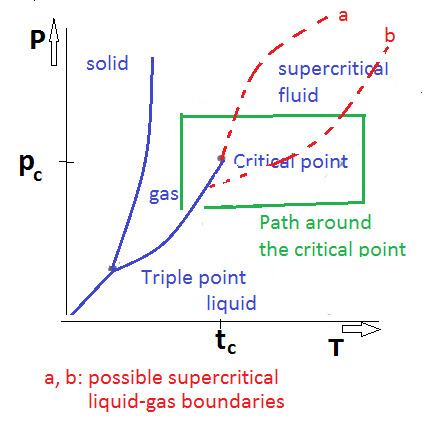 | ||
Supercritical liquid–gas boundaries are lines in the p–T diagram that delimit more liquid-like and more gas-like states of a supercritical fluid. They comprise the Fisher–Widom line, the Widom line, and the Frenkel line.
Overview
According to textbook knowledge, it is possible to transform a liquid continuously into a gas, without undergoing a phase transition, by heating and compressing strongly enough to go around the critical point. However, different criteria still allow to distinguish liquid-like and more gas-like states of a supercritical fluid. These criteria result in different boundaries in the pT plane. These lines emanate either from the critical point, or from the liquid–vapor boundary (boiling curve) somewhat below the critical point. They do not correspond to first or second order phase transitions, but to weaker singularities.
The Fisher–Widom line is the boundary between monotonic and oscillating asymptotics of the pair correlation function
The Widom line is a generalization thereof, apparently introduced by H. Eugene Stanley.
The Frenkel line is a boundary between "rigid" and "non-rigid" fluids characterized by the onset of transverse sound modes.
One of the above mentioned criteria is based on the velocity autocorrelation function (vacf): below the Frenkel line the vacf demonstrates oscillatory behaviour, while above it the vacf monotonically decays to zero. The second criterion is based on the fact that at moderate temperatures liquids can sustain transverse excitations, which disappear upon heating. One further criterion is based on isochoric heat capacity measurements. The isochoric heat capacity per particle of a monatomic liquid near to the melting line is close to
Anisimov et al. (2004), without referring to Frenkel, Fisher or Widom, reviewed thermodynamic derivatives (specific heat, expansion coefficient, compressibility) and transport coefficients (viscosity, speed of sound) in supercritical water, and found pronounced extrema as function of pressure up to 100 K above Tc.
